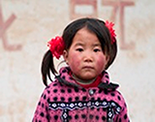Whenever a newcomer enters the classroom, he points at the wall.
"Look at that!" says Li Shunye, indicating a picture of something that looks a bit like a pink furry fox, only with an over-sized tail.
 ©UNICEF/China/2006 ©UNICEF/China/2006
A girl reads out in a class session. |
"It's a squirrel," says the 9-year-old. "I made it."
Fox or squirrel, it doesn't matter because Shunye still feels like king of the castle: The wall is ablaze with sunshine, houses, chimneys, flowers, trees, monkeys, roosters, dolls and a fat gray cat with extra-long whiskers.
Until recently, ne'er a smiley sunshine face was to be seen at Shuiquan Elementary School in central Gansu Province: posted on the walls instead were articles 1-10 of the comprehensive school regulations and various slogans exhorting students to study hard, study every day, and so on.
Nowadays, says Shunye, students are exhorted to play a game or sing a song at the beginning of class. Those who get the right answer receive applause from their classmates. Students swap seats and form discussion groups.
"It makes the atmosphere much more lively," he says. "I am constantly concentrating and being encouraged."
"I love going to school because I love my teacher Miss Li, who is always in a good mood and smiles to us in class," he says.
It's outside in the playground where Shunye feels happiest. He can play basketball now because the hoop doesn't wobble precariously anymore.
"Last winter, our teachers reinforced the base with steel so that the hoop was fixed when we shoot ball," says the third-grader. Plus, the court is smoother too, says Shunye, because teachers filled potholes with sand and removed all the big stones.
Chalk & talk
Located in Tianzhu Tibetan Autonomous County, the 761-square-meter school consists of four red-brick single-story houses accommodating 212 students. Their parents earn on average 1,523 yuan (US$ 190) a year, less than half the rural Chinese average of 3,255 yuan (US$ 407).
The United Nations Children's Fund (UNICEF) in 2004 decided to install Shuiquan in its child-friendly school framework, affecting 500,000 students in at least 1,000 rural schools in 20 counties in China's ten provinces since 2001.
 ©UNICEF/China/2006 ©UNICEF/China/2006
Smiling children. |
"The framework is designed to create a child-friendly learning environment where child-centered and activity-based teaching and learning processes help children fully develop their potential," says Guo Xiaoping, a UNICEF-China educational official.
The traditional "chalk-and-talk" -- teacher-centered -- teaching methodology dominates schools in the Chinese mainland. A frowning teacher, a bullying father or a pleading mother browbeats the child to study harder.
Playtime is more and more trimmed to make way for more and more study. Children today, says Guo, are caught up in an endless race of extra tuition sessions, piano lessons, late-night homework and much, much more.
"Education should not overload students with stress but prepare them for success. We need to give students the tools they need to build up their confidence."
The child-friendly school framework, first tried in Thailand in 1997, was conceived as a means of converting the theory of the United Nations Convention on the Rights of the Child into actual practice in the classroom.
 ©UNICEF/China/2006 ©UNICEF/China/2006
Students smile for a group photo. |
"This is also in accordance with ongoing educational reform shifting from traditional teaching methods and classroom setups that favor authority and discipline into active, cooperative and democratic learning methods, which promote students' creativity and autonomy," she says.
Child-friendly schooling, explains Guo, consists of five broad dimensions:
• inclusiveness;
• effectiveness;
• health, safety and protection;
• gender-friendliness; and,
• the involvement of students, families and communities
Inclusiveness
UNICEF East Asia and Pacific Regional Office Youth and Partnership Project Officer Joachim Theis visited the child-friendly schools of Tianzhu Tibetan Autonomous Region.
"Inclusiveness means proactively inclusive, seeking out and enabling the participation of all children and especially those who are different ethnically, culturally, linguistically, socio-economically and in terms of ability."
"That requires individualized teaching. For those students who don't like sitting still and keep moving, they are already at a disadvantage if they are treated the same as their classmates."
Theis believes strongly that children should not be marginalized by teachers who do not engage them, do not believe they are capable of learning and do not have the teaching skills to handle their diversity.
In short, he says, it's about learning to talk the same language.
"I had thought that my teachers and schoolmates would barely understand me," says Qian Li, "because I speak Tibetan in the family and I am not good at Chinese."
The 11-year-old studies Tibetan, Chinese and English with her Tibetan classmates at Tianzhu Elementary School, affiliated to the Tianzhu Normal Institute.
Li's herder parents have rented an apartment in the county town of Tianzhu Tibetan Autonomous County to help their daughter qualify for a better elementary school and the chance of a better high school.
"I feel comfortable here speaking and learning my own language while learning English," says the fifth-grader. "I think English is not difficult compared to Tibetan. Maybe in the future, I can teach foreigners Tibetan."
There is also a Tibetan-language class for the 721 Tibetan students of Tianzhu Elementary School affiliated with Tianzhu Normal Institute.
"Actually, these exclusionary factors that may be more culturally or politically sensitive -- such as language, religion or gender inequalities -- should be given more attention," says Theis.
Health and safety
A child-friendly school "should not only protect the children's physical condition, but also their emotional and psychological well-being," says Guo.
Wang Hong, 11, was buoyed by her experience of giving the wrong answer in her class at Shimen Center Elementary School of Tianzhu Tibetan Autonomous County.
"When I stood up to answer a question I was confident -- only to find out that the teacher had asked another question. It was so embarrassing at first," says the fifth-grader.
"But the teacher asked me to speak it out again, and then asked the whole class to discuss my question first. He told me each question has various answers rather than one solution."
Wang says she loves the feeling when her classmates applaud her.
"In the past, students just followed the teacher's directions. Now it's a good feeling to be acknowledged by your peers."
Classmate Wang Ling agrees. Selected last semester to be a member of the school advisory board, Wang made a suggestion on behalf of her classmates that the teacher organize a performance for the school's New Year celebrations.
"We really had fun during the celebration," says Wang. "Girls wore their beautiful skirts while the boys dressed like gentlemen. "
"We designed the performance ourselves. It was a good feeling that your suggestions are taken into consideration and you can speak for children's own ideas."
Teachers used to be in charge of everything at school, she says, but the advisory board now acts more like a bridge between students and teachers. Students often approach Wang to share their ideas.
"It is so nice to be needed," says the 11-year-old. "You know what? Here in our school, everyone counts."
 ©UNICEF/China/2006 ©UNICEF/China/2006
Children smile for a group photo. |
Gender-responsive
A child-friendly school should also be "gender-responsive", creating environments of gender equality for the students through the active engagement of family and community in all aspects of school policy, management and support to children.
When a maths teacher at Shuiquan Elementary School noticed all the girls were sitting together in a discussion group, she knew what to do. Li Jingling invited the students to change seats, mixing girls and boys together in different groups.
"After I attended the workshop organized by UNICEF on child-friendly schooling and child participation last November, I began to realize the importance of interactive learning, not only between teachers and students, but among students of different gender," says Li.
After the first class with boys, says Li, one of the girls approached her and said it was efficient and interesting to work with boys together because "in rural places, girls sometimes feel inferior to boys, and even jealous about the boys as they are considered the center of the family."
Li hopes that gender-sensitive teaching will also prepare students to live more harmoniously with the opposite gender in wider society.
As Joachim Theis puts it, “If the teacher just changes the order of the seats instead of the teaching methods, it's useless.
"It depends a lot on the teacher. Some poor places can have good teachers. Also with good facilities, teachers can disappoint students."
Effectiveness
A high-quality education is not all just about literacy and numeracy, says Guo. It's about the school's effectiveness based on a human-rights approach that includes cultural diversity, multilingualism in education, peace and non-violence, sustainable development and life skills.
Shunye complains that his parents sometimes beat him when he misbehaves. "Sometimes my parents yell at me saying I am stupid, which hurts me even more than being beaten," he says.
Teacher Li Jingling still worries about the practicality of child-friendly teaching.
"Some parents tell us to punish their kids as severely and as often as we can, otherwise they worry their child won't study hard. "
"So by us granting some autonomy to children, they consider us irresponsible."
The greatest challenge to child participation, according to a trainer for the UNICEF workshop and a professor with China's Women University, is adults.
"Adults are gatekeepers," says Professor Jiao Jian. "They create opportunities for children and also they set limits sometimes. Adults will decide how much autonomy should be given to children. Sometimes they find an excuse not to promote children's rights."
Problems include not only parental expectations and examination pressures, but a lack of boldness in taking on the status quo among teachers and education officials.
"So it is society and people that ultimately determine how far child participation can go," she says.
But history is on her side, believes Prof. Jiao. "China needs a new type of human resources during the shift from an agricultural to a globalised society. That requires a sound fundamental relationship between the state and citizens, teachers and students, parents and children. "
"If we don't let students feel this equal relationship in class, they will be completely overwhelmed when they come into the society."
(by Rong Jiaojiao, China Features)
































